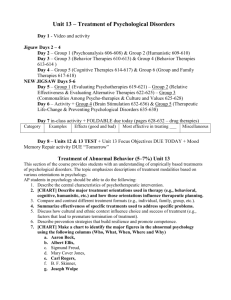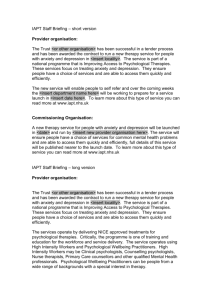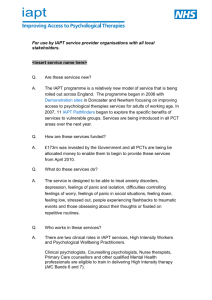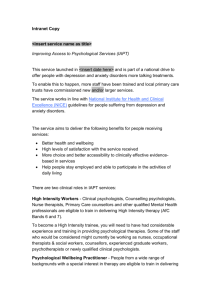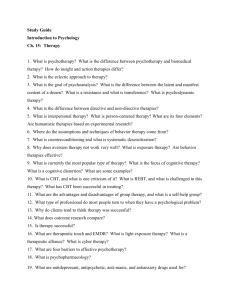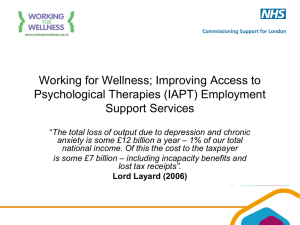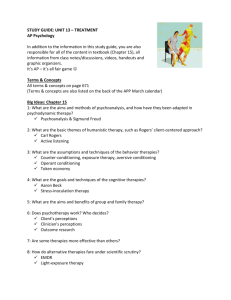Talking therapies: A four-year plan of action A supporting document to
advertisement
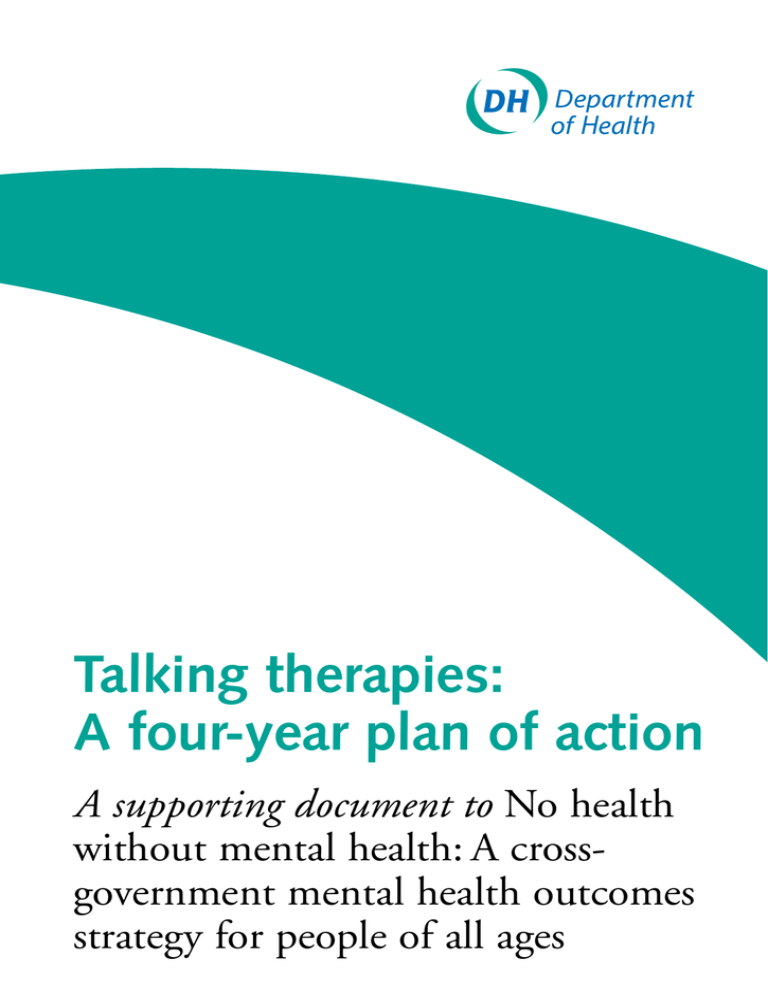
Talking therapies: A four-year plan of action � A supporting document to No health without mental health: A crossgovernment mental health outcomes strategy for people of all ages Contents Foreword by the Minister of State for Care Services � 2 � Talking therapies: A four-year plan of action 3 � Introduction 3 � Equalities and human rights 4 � Background 5 � Completing the roll-out of Improving Access to Psychological Therapies 7 � Completing the training programme 7 � Extending the training programme 8 � Better access for older people 9 � Delivering improved quality standards 11 � Choice and equity for patients 12 � Employment and other activity support 12 � The Improving Access to Psychological Therapies service model 13 � New elements in the expanded programme 16 � Children and young people 17 � Long-term conditions 19 � Medically unexplained symptoms 20 � Severe mental illness 21 � Next steps Annex: Benefits realisation 23 24 � 1 Foreword by the Minister of State for Care Services Following the recession, it is clear that we need to heal emotional wounds, which means that we are looking for a psychological recovery alongside our economic recovery. In that context, the Prime Minister’s plan to make general wellbeing a key measure of success is highly symbolic, because what a government measures affects what it does. The Coalition Government’s approach to talking therapies is vitally important in demonstrating this; we confirmed £70 million for the Improving Access to Psychological Therapies programme in June 2010. We went on to include the programme in our Spending Review settlement for health in October 2010 and in the NHS Operating Framework for 2011/12 which was published in December 2010. And now, talking therapies are a major element of our cross-government mental health strategy, No health without mental health, which this four-year plan of action accompanies. This is backed by an investment of around £400 million over the four years to 2014/15. By then, every adult that requires it should have access to psychological therapies to treat anxiety disorders or depression. Our ambition is to make the same step forward for children and young people as we have made for adults. We also want to broaden the benefits to people with long-term physical or mental health conditions. We can no longer have a health service that treats people physically but leaves them struggling mentally. One of the most important innovations in psychological therapies has been session-by-session outcome monitoring, which is in place in new services. This body of data gives us formidable evidence on how these therapies help a person’s recovery. We need to make sure that the extremely strong case for investing in therapies now to save costs to acute care, social care and other public services is heard and understood. Be in no doubt. The momentum and the political will is there. This is a deep commitment for me, and for the Government. Paul Burstow MP Minister of State for Care Services 2 Talking therapies: A four-year plan of action Introduction 1.� This plan accompanies the cross-government mental health strategy, No health without mental health. It outlines how the Government’s commitment to expanding access to psychological therapies will be achieved in the four years from April 2011, ensuring business continuity during structural reform of the NHS. 2.� The Government has demonstrated the importance it attaches to talking therapies by including them in The Coalition: our programme for government and the Spending Review and by making them the subject of a ministerial keynote speech. It also confirmed £70 million in June to fund the third year of the Improving Access to Psychological Therapies (IAPT) programme that began in 2008. 3.� The aim is to develop talking therapies services that offer treatments for depression and anxiety disorders approved by the National Institute for Health and Clinical Excellence (NICE) across England by March 2015, the end of the Spending Review period. This involves: •� completing the nationwide roll-out of IAPT services for adults of all ages who have depression or anxiety disorders, paying particular attention to ensuring appropriate access for people over 65; •� initiating a stand-alone programme to extend access to psychological therapies to children and young people, building on learning from the IAPT programme and using NICE-approved and ‘best evidence’-based therapies where NICE guidelines are pending; •� broadening the benefits of talking therapies by extending them to people with physical long-term conditions or medically unexplained symptoms, which are physical symptoms caused by psychological distress; and •� expanding access to talking therapies services for people with severe mental illness. 4.� This plan will also contribute to achieving the high-level objectives in No health without mental health by increasing the number of people who improve their mental health and by giving more people a positive experience of care. 3 Talking therapies: A four-year plan of action 5.� Four key principles underpin the approach. In order to encourage highquality training and excellent performance, the Outcomes Framework and payments to service providers will be based on these principles. They are: •� better access to services; •� clinical improvement and recovery; •� improved social and economic participation, including employment for working-age people; and •� increased patient choice and satisfaction. 6.� People needing to access talking therapies will have more choice and better information about what to expect from services, as well as the opportunity to rate the services they have received. Service performance reports will be placed in the public domain to demonstrate the outcomes that services have delivered. Care will be delivered in a patient-centred way, supporting the individual to stay in or return to work, or to increase their participation in social, educational or training activities. 7.� We will know we are succeeding when: •� more people of all ages are improving their mental health and wellbeing by accessing NICE-approved psychological therapies; •� more people with long-term physical health conditions, medically unexplained symptoms or severe mental illness are routinely offered evidence-based psychological treatments when appropriate, as part of personalised care planning; •� more people from the whole community, with lived experience of these situations, are involved in leading the changes this plan seeks to secure; and •� more people are able to resume or start normal working lives after coming off sick pay or benefits linked to their depression or anxiety disorder. Equalities and human rights 8.� 4 The talking therapies four-year plan of action aims to ensure that equality and human rights are integral to equitable and inclusive IAPT services. Equality objectives will be embedded and implemented using the results of patient satisfaction surveys, the systematic collation and analysis of demographic data, and partnership work with organisations that represent diverse communities. Talking therapies: A four-year plan of action 9.� We will know we are achieving equality and human rights objectives when: •� the proportion of patients using IAPT services is in line with both prevalence and the community profile; •� a diverse group of people choose to access psychological therapies to improve their mental health; and •� recovery rates are unaffected by age, race, religion or belief, sex, sexual orientation, disability, marriage and civil partnership, pregnancy and maternity, or gender reassignment. Background 10.� The IAPT programme was created to offer patients a realistic and routine first-line treatment for depression and anxiety disorders, combined where appropriate with medication – which had traditionally often been the only treatment available. The programme was first targeted at people of working age. The economic case on which it was based showed that providing therapy could benefit not only the individual but also the nation, by helping people come off sick pay and benefits and stay in or return to work. 11.� From the outset, it recognised that a national shortage of cognitive behavioural therapy (CBT) practitioners, who are skilled in helping people recover from depression and anxiety disorders, was the core deficiency preventing routine NHS delivery of the NICE guidelines. 12.� The programme began with two demonstration sites in 2006/07, which tested and developed care pathways and the skills needed to deliver NICEapproved therapy. They succeeded in demonstrating impressive recovery rates that reflected those achieved in clinical trials, with around half of those people completing treatment moving to recovery. They also succeeded in helping people off sick pay and benefits so that they could stay in or return to work and highlighted the importance of self-referral in enabling some people to access the services. 13.� The following year, 11 pathfinder primary care trusts (PCTs) took a special interest in the psychological therapy needs of one or more of a range of specific groups in the community and produced positive practice guides, including for children, older people and people from minority ethnic communities. 14.� The evidence that proved CBT is as effective as medication in helping people with depression and anxiety disorders – and better at preventing relapse – led to the economic case that secured annual funding to begin the national 5 Talking therapies: A four-year plan of action roll-out in the three years to March 2011. Key to the economic case was an argument that effective therapeutic interventions combined with employment support could reduce the numbers of people on sick pay and benefits. 15.� Principally, the economic case enabled training programmes to be created so that therapists could offer high-intensity treatments to people with moderate to severe depression or anxiety disorders and so that psychological wellbeing practitioners could offer guided self-help to people with mild to moderate depression. 16.� The shortage of people with these skills was so acute and the need for quality so fundamental that the number of trainees had to be restricted to those who could be properly supervised by an experienced therapist. As more people were trained up, the pace of the roll-out increased. In 2011, more than 3,700 therapists and psychological wellbeing practitioners will have been trained, exceeding the original plans. The services created have been able to work efficiently with high numbers of patients, stepping people up to more intensive therapy if guided self-help did not achieve expected improvements in wellbeing. 17.� In 2009, funding was made available so that IAPT services could offer employment support to service users, recognising the importance of offering this as a core element of the IAPT service model. 18.� It is expected that the new services will cover around 60% of the population by March 2011. A quarter of the sites have reached the expected recovery rate of half of all patients who complete treatment. The potential benefits across the country are clear and the early successes have led to a realisation that the approach can be expanded to address a number of particular needs. 19.� An overarching achievement of the programme has been the transformative effect it has had in revolutionising the monitoring of mental health improvement and recovery by commissioners in the NHS and their service providers in the areas which have so far joined the IAPT programme. 20.� Use of a session-by-session monitoring system means that, for the first time, systematic data are available on more than 90% of people receiving treatment. These data indicate that by September 2010 the programme had helped more than 72,000 people to recover from depression and anxiety disorders in the previous two years and very nearly 14,000 people had moved off sick pay and benefits and started or returned to work following their treatment. 6 Talking therapies: A four-year plan of action Completing the roll-out of Improving Access to Psychological Therapies 21.� The phased roll-out has, inevitably, created a situation in its first three years where some places are covered by the new services and others are not. This was a result of the national shortage of suitably qualified supervisors for the trainees, which in turn was the reason why the programme was always expected to take six years to complete. 22.� Some of the services still have some way to go to become fully established and to deliver the quality standards expected. By March 2011, 3,700 new therapy workers will be trained or will have started their training. 23.� The Government’s Spending Review settlement committed to completing the roll-out, which will involve addressing unmet need and delivering equity of access. Specifically, completing the roll-out has six core elements: • completing the training programme; • extending the training programme; • better access for older adults; • delivering improved quality standards; • choice and equity for patients; and • employment and other activity support. Completing the training programme 24.� Cohorts of trainees will be recruited in each of the next three academic years to bring the total of additional trained CBT workers (high-intensity therapists and psychological wellbeing practitioners) over the six-year roll-out period to approximately 6,000. There will also be a proportionate increase in every region in training for therapy workers who deliver other NICE-approved modalities for treating depression and anxiety disorders. 25.� The initial intention to establish a strong core of CBT-trained therapists and psychological wellbeing practitioners remains, with regional flexibility to ensure that training plans meet the needs of local commissioners. This may involve other agencies from the private, public and voluntary sectors. 26.� Top-up training to develop existing, qualified therapists in the other four NICE-approved modalities for treating depression will continue. These modalities are: interpersonal psychotherapy, counselling for depression, brief dynamic interpersonal therapy, and couple therapy for depression. This training includes ensuring that the core characteristic of IAPT services, 7 Talking therapies: A four-year plan of action sessional outcome monitoring, is a key feature of all these treatments. The numbers of therapists in these modalities are hard to estimate at this stage, as levels of top-up training will be determined locally, but they will draw on the existing counselling and psychotherapy workforce. 27.� Administering the funding for trainees centrally, as in the past, would be inconsistent with the NHS reform agenda. A new funding route is required and the intention is to ensure completion of the training programme by mainstreaming funding for training through the Multi-Professional Education and Training (MPET) budget, the mechanism that funds NHS clinical training programmes. MPET funding is normally allocated using a weighted capitation method. 28.� Identifying IAPT funds within MPET, combined with the inclusion of psychological therapies in the NHS Operating Framework for 2011/12, gives IAPT a national profile within the existing financial system. Training and salary costs for the 2011/12 trainees are included in this funding stream, although they will not be ring-fenced and there may be regional differences in how this is implemented in line with local need. Once trained, therapists will be funded by PCTs (or their successor organisations) from baseline allocations. As MPET covers staff working in NHS-funded services, this allows for trainees and staff in the voluntary sector to access training places. Employment support funding will also be included in PCT baseline allocations in 2011/12. 29.� All IAPT services will deliver employment support. The approach taken on this is for local determination, but funding to support one employment support worker for every eight therapists will be available by 2013/14. Extending the training programme 30.� Current training systems for IAPT staff will consolidate and sustain the workforce required for full roll-out. New training systems will be identified to support the extension of talking therapies to children and young people, older people, and people with long-term physical or mental health problems, including those with medically unexplained symptoms or severe mental illness. 31.� The principles that underpinned workforce development in the existing programme will be applied, where appropriate, to training focused around these client groups. These principles are: 8 Talking therapies: A four-year plan of action •� analysing demand, based on epidemiology and local presentation; •� a service model (see Figure 1, page 14) based on stepped care, and care pathways focused on people presenting with identifiable needs or problems; •� competence frameworks underpinning therapy practice, training curricula and supervised practice and based on NICE guidelines and evidence from large clinical trials; •� a workforce employed to deliver relevant evidence-based interventions at steps 2 and 3 of the stepped care model (see Figure 2, page 15); and •� generic competences (including outcome monitoring, the stepped care service model, equalities and the importance of risk assessment and management) underpinning specific competences in NICE-recommended interventions. 32.� The degree to which these principles apply for each new client group will be assessed. The services and the workforce trained to deliver them will offer NICE-approved interventions in a stepped care model which ensures that delivery is effective and efficient. Work to co-ordinate and collaborate with other psychological intervention strategies, including IAPT for those with personality disorders, will be undertaken. 33.� Training models will span generic and specific competence frameworks, addressing the needs of the existing workforce, as well as having the capability to evolve new roles for practitioners. Full- and part-time training may be offered as continuing professional development or specific courses to train two types of worker: those offering high-intensity interventions and those offering less intense treatment. 34.� The trainees’ knowledge and experience of the relevant client groups will be important considerations in the design of the training programmes. Selection processes for these new training programmes will be accessible nationally and will be competitively based so that trainees are suitable and of high calibre. Better access for older people 35.� Analysis of data from IAPT’s first-wave sites indicated that adults over the age of 65 represented an average of only 4% of those accessing IAPT services between October 2008 and September 2009. There was significant variation between sites: some saw no-one over 65 at all, while at other sites over-65s accounted for considerably more than 4% of the client base. The Adult Psychiatric Morbidity Survey assesses prevalence of depression among 65–74-year-olds at 10.6% and among all adults at 16%. The expected rate of over-65s in IAPT services, given the age profile of the population and the community prevalence of depression and anxiety disorders, is 12%. 9 Talking therapies: A four-year plan of action 36.� Clearly, older people have been significantly under-represented in IAPT services’ patient profiles. This is a matter of concern that must be tackled, especially as age is a protected characteristic under the Equality Act 2010 and public bodies have a duty to ban age discrimination in services from April 2012. The legislation means that IAPT services have a legal responsibility to demonstrate that older people and other protected groups are safe from discriminatory practices. 37.� The access issues for older people will be addressed by: •� using the IAPT data standard (which includes information about age) to assess use of IAPT services by people over 65 and to take steps to improve access for such individuals when they are under-represented; •� involving organisations that represent older people in: –� understanding the reasons why older people are under-represented in IAPT services, including exploring the impact of stigma, structural barriers and more age-appropriate delivery methods, such as home visits; and –� leading the development of Patient Reported Outcome Measures (PROMs) as part of the routine sessional outcome measurement for older people in IAPT services; and •� engaging specialists in older people’s care, including dementia, in: –� developing understanding of the level of unmet need; –� designing appropriate care pathways that take account of older people’s needs for flexibility in services, which may involve longer treatment sessions or offering treatment in accessible and suitable alternative venues; –� working with the National Dementia Strategy team to highlight the mental health needs of those of all ages who care for people with dementia and specifically seeking to expand access to carers, so that they are better supported in managing challenging behaviours. This will also help to optimise the appropriate prescribing of antipsychotic medication for people with dementia; –� working with the national Carers Strategy and Older People teams to seek to expand IAPT access to older carers; 10 Talking therapies: A four-year plan of action –� developing continuous professional development for GPs; primary care, social care and nursing home staff; specialists in older people’s care; and others, to improve recognition and management of depression and anxiety disorders; and –� acting to reduce stigma and encourage greater recognition and use of services by older people. 38.� The IAPT data standard, when it is introduced, will capture the age of patients as well as other demographic information so that services will be able to take action to correct under-representation of particular groups. Some IAPT sites have already succeeded in monitoring this effectively and in taking appropriate action where necessary. Delivering improved quality standards 39.� All IAPT services routinely collect sessional PROMs, which inform patients of their progress, support clinicians to improve their practice and help commissioners to plan and monitor services. 40.� Historically, these data have informed national performance indicators. However, from 2011/12, the intention is to transition to a new reporting system that will facilitate: •� local benchmarking and outcome reporting; •� improved patient choice and satisfaction outcome monitoring; •� the development of an outcome tariff to enable the piloting of payment by results (PbR) in IAPT services in 2011/12; and •� inclusion of non-clinical outcomes, including social and economic participation outcomes. 41.� To supplement the development of this Outcomes Framework, local services will continue to participate in clinical audits to improve the quality of the services they provide. A national audit of first-year IAPT sites demonstrated that clinical improvement and recovery of people using IAPT services is greatly enhanced where services provide: •� information to patients at every session about their clinical scores, indicating improvement in their condition or not; •� an effective system of stepped care to allow patients to receive the appropriate dose and level of treatment to meet their needs; and •� NICE-compliant therapies that reflect the particular condition. 11 Talking therapies: A four-year plan of action 42.� Local, regional and national clinical networks will support this process and provide tools and advice to local services to support continuous service improvement. Choice and equity for patients 43.� The consultation document Liberating the NHS: Greater choice and control (HM Government, October 2010) sets out proposals for offering patients greater choice and control over their care and treatment. This consultation closed on 14 January and a response will be published shortly. This will set out an overview of the responses and emerging policy options and will ask further questions about some of the detail of implementation. 44.� It is important not to pre-judge the outcome of this consultation but it should be recognised that NICE has approved a number of evidence-based therapies for treating depression (some in particular circumstances). This requires IAPT services to invest in training in approved therapy modalities, putting in place delivery arrangements that offer choice. This needs to take account of the commitment by the Government to create a presumption that all patients will be able to choose from any willing provider. 45.� Demand for evidence-based psychological therapies services remains high across all communities. Some groups may have higher prevalence of anxiety disorders and depression than others, such as carers, victims of crime, the homeless, offenders, addicts, military veterans and people with long-term physical conditions. Other groups may have proportionately lower levels of identification despite high levels of need, such as people who are gay, lesbian or bisexual. Services must take the needs of all these groups into account alongside those with the legally protected characteristics of age, race, religion or belief, sex, sexual orientation, disability, marriage and civil partnership, pregnancy and maternity, or gender reassignment. 46.� A detailed workplan is being prepared to complete the roll-out of IAPT and to ensure better access for older people, with new governance arrangements to support it. Employment and other activity support 47.� It is widely accepted that work is generally good for mental health – including for people with mental health conditions. Evidence shows that the longer people are absent from – or out of – work, the more likely they are to experience depression and anxiety disorders. 12 Talking therapies: A four-year plan of action 48.� However, too many people with depression or anxiety disorders are not in employment and so miss out on the advantages that work offers – only 54% of people with a common mental health condition are in work. Also, of the 2.6 million people currently on out-of-work, health-related benefits, around 42% are claiming primarily because of mental health conditions. Mental ill health accounts for around 200,000 new claims for health-related benefits (a third of the total) each year. 49.� Timely, co-ordinated health and employment interventions can help people to gain and retain employment, reduce avoidable job loss and help people to return to work from benefits or sick pay. Ensuring that employment advice is delivered as a core part of psychological therapy services is a key principle and a vital element of the roll-out. 50.� This plan principally focuses on describing the new policy areas being developed. It will result in a revised delivery plan that sets out the key milestones for completing the roll-out of the original IAPT programme for adults. The Improving Access to Psychological Therapies service model 51.� The service model (shown in Figure 1, page 14) has been thoroughly tried and tested in the first three years of the programme. It is based on a ratio of around 40 therapists serving a population of 250,000, with some flexibility to suit local circumstances. The teams of therapists and psychological wellbeing practitioners deliver NICE-approved interventions to people with depression and/or anxiety disorders in a system of stepped care (shown in Figure 2, page 15) linked to employment and primary care support. 52.� The service aims to offer equity of access to everyone who needs it. Patients may be referred by their GP – or they can refer themselves. Initial fears that self-referral would open the floodgates and over-burden services have proved unfounded. 13 Talking therapies: A four-year plan of action Figure 1: Recommended stepped care pathway for IAPT services Specialist mental health services including step 4: Psychological therapy services Treatment Step 3: High­intensity interventions Where an onward referral is a requirement and patient consent has been obtained, outcomes of treatment should be communicated to the new service/team 14 days Step 1: Promotion of service, including clear access criteria and scope of service Self­help materials Active monitoring Referral to service Sources include self­referral, GP, community services, job centres 14 days Assessment: decision to treat Choice of NICE­indicated treatment discussed with patient Sessional outcome monitoring indicates need to step up, discharge or refer on Discharge or onward referral 14 days Patient declines treatment, does not attend assessment or is found not suitable. Next steps discussed with patient. Referrer informed promptly of outcome Treatment Step 2: Low­intensity interventions Patient ends treatment (either planned or unplanned) and has provided consent for outcomes to be communicated to referrer, including requirements for ongoing monitoring and follow­ up (six months) 14 Talking therapies: A four-year plan of action Figure 2: NICE-indicated treatments for depression and anxiety disorders Depression: moderate to severe Cognitive behavioural therapy (CBT) or interpersonal psychotherapy (IPT), each with medication CBT or IPT Behavioural activation (BA), a variant of CBT1 Depression: mild to moderate for individuals with an inadequate response to initial interventions at step 2 Step 3: High-intensity interventions Step 2: Low-intensity interventions Step 1: Primary care/ IAPT service Couple therapy (if the patient has a partner, the relationship is considered to be contributing to the maintenance of the depression, and both parties wish to work together in therapy) Counselling2 or brief dynamic interpersonal therapy2 (consider if patient has declined CBT, IPT, BA or couple therapy) Panic disorder CBT Post-traumatic stress disorder (PTSD)3 CBT or eye movement desensitisation and reprocessing (EMDR) therapy Generalised anxiety disorder (GAD) CBT Obsessive compulsive disorder (OCD) CBT Social phobia4 CBT Depression Guided self-help based on CBT, computerised CBT, BA, structured physical activity Panic disorder Self-help based on CBT, computerised CBT PTSD3 None GAD Self-help based on CBT, psycho-educational groups, computerised CBT OCD Guided self-help based on CBT Social phobia4 None Recognition of problem Assessment/referral/active monitoring include careful monitoring of symptoms, psychoeducation about the disorder and sleep hygiene advice Moderate to severe depression with a chronic physical health problem Collaborative care (consider in light of specialist assessment if depression has not responded to initial course of high-intensity intervention and/or medication) 1 Although the recent update of the NICE guidance on depression recommends BA for the treatment of mild to moderate depression, it notes that the evidence base is not as strong as for CBT or IPT. See NICE (2009) Depression. CG90. � 2 NICE (2009) Depression. CG90; NICE (2009) Depression in adults with a chronic physical health problem. CG91. The two guidelines are very similar; however, it should be noted that CG91 does not recommend IPT, BA, counselling or brief dynamic interpersonal therapy as high-intensity interventions. � 3 NICE has not recommended low-intensity treatments. � 4 NICE has not yet issued guidance on the treatment of social phobia. However, there is a substantial body of evidence that supports the effectiveness of high-intensity CBT. Low-intensity versions of CBT are being developed by several groups around the world and are likely to play a useful role in the future. At least one trial has also demonstrated that IPT is effective. � 15 Talking therapies: A four-year plan of action New elements in the expanded programme 53.� Alongside completing the roll-out of the programme that began in 2008, the Spending Review settlement allows progress to be made on three other strands that also focus on expanding access to psychological therapies. These are: •� children and young people; •� people with long-term physical conditions or medically unexplained symptoms; and •� people with severe mental illness. 54.� While the ambition is to ensure a similar stepped improvement in access to talking therapies for these other groups (as has been delivered for adults), all three are in the very early stages of planning. They will all involve their key stakeholders – patients and carers with relevant lived experience, physicians and therapists – in developing appropriate service models. 55.� It is important for services to obtain feedback from a wide range of local stakeholders, especially groups that are difficult to engage, so that services are delivered in ways that they can receive. This means that services should not assume that exactly the same model of care would be chosen by all who needed this kind of treatment. 56.� Two important groups of stakeholders have agreed to channel a wide range of opinions into the workstreams, informing and shaping policy and practice. These groups are We Need To Talk, a coalition of the main mental health charities that represents and involves service users and their carers, and the New Savoy Partnership, a group that represents a wide range of professional bodies. 57.� The programme will link with Department for Work and Pensions, Department for Education and Department of Health policy teams focused on carers of all ages, long-term conditions, older people, dementia, and children and young people. For example, any carer experiencing depression or anxiety disorder – whether as a result of their caring or not – should be able to access local NICE-approved treatments from local services where they have been set up under the IAPT programme. 58.� The funding available will enable preliminary work to take place that assesses the scope and scale of what needs to be done in each of the new work areas so that a business case for funding for their full roll-out can be considered on the basis of clear information. 16 Talking therapies: A four-year plan of action Children and young people 59.� Depression, anxiety disorders, self-harm and eating disorders, together with conduct disorders, make up the majority of referrals to specialist Child and Adolescent Mental Health Services (CAMHS). 60.� Evidence shows that similar psychological interventions to those offered by the IAPT programme for adults of all ages would be effective in meeting the needs of children and young people with depression, anxiety and conduct disorders. However, delivering therapies for these age groups requires expertise and experience in engaging and working with young people and their families through to adolescence and young adulthood, as well as skills to deliver evidence-based therapies. 61.� Many children and young people with these needs are unable to access such treatments due partly to a lack of skills within the CAMHS workforce and partly to the fact that the most severe cases are prioritised, with the result that others who would benefit from treatment are unable to be seen. Treatments currently provided for children and young people are not always firmly based on NICE and best practice guidelines.1 62.� The scope of the programme for children and young people is still to be determined. This will involve discussions with a wide range of stakeholders. Our emerging approach, to be further tested and refined, will seek to address this chiefly through transforming practice in existing tier 2 and 3 CAMHS provision, alongside a limited expansion of capacity, to improve access to evidence-based therapies by: •� involving clinical leaders, including GPs, and leading children’s mental health charities such as YoungMinds in building the capability of the CAMHS workforce through an education and training programme that includes: –� competency frameworks, curricula and training materials for the NICE-approved and evidence-based interventions, which will be developed with advice from an expert reference group. The curricula and training materials will be designed to support participants to take on a lead role back in their services for achieving wider change in practice among their peers, so driving up the quality of CAMHS generally across tiers 2 and 3; –� commissioning training for existing staff and a limited intake of new staff, beginning in 2011/12; and 1 In a national survey of CAMHS, two-thirds of therapists (n = 540) in the sample reported needing more training in core CBT. See Stallard P, Udwin O, Goddard M and Hibbert S (2007) The availability of cognitive behaviour therapy within specialist child and adolescent mental health services (CAMHS): A national survey. Behavioural and Cognitive Psychotherapy 35(4): 501–5. 17 Talking therapies: A four-year plan of action –� making best use of the existing IAPT education and training infrastructure, adapting it for children and young people and their families; •� establishing a change programme in early adopter sites, ideally in every strategic health authority (SHA) area, to: –� provide supervised practice in the relevant therapies for both existing staff and new staff who are in training; –� provide training in assessment for senior staff; –� transform supervision and outcomes-focused service feedback processes, with the full participation of children and young people and their families who use the service; –� test and refine the approach to service transformation, with a view to establishing a second and third wave in years 2 and 3; and –� develop care pathways, service models and interfaces with adult IAPT services, together with an understanding of the level of unmet need for these services; and •� involving children and young service users and their families in developing valid, user-focused and patient reported outcome measures (PROMs) at every session. These will form part of a routine outcome measurement framework that provides standardised assessment of each child’s clinical improvement/ development and recovery. This will be informed by the IAPT framework and might include: –� recovery/improvement; –� personalisation and choice; –� social participation, particularly educational and vocational inclusion; and –� service user experience. 63.� To secure participation in the early adopter programme, both local commissioners and providers must demonstrate that they have the capacity and commitment to deliver the transformational change required. Should the first wave of early adopters deliver evidence of success, there would be scope to scale up the programme. Equally, should the first wave fail to show signs of securing the transformational change proposed, the approach could be modified. 18 Talking therapies: A four-year plan of action Long-term conditions 64.� People with long-term physical health conditions (LTCs) such as diabetes, cardiovascular disease (CVD) or chronic obstructive pulmonary disease (COPD) often have comorbid mental health conditions. They are rarely referred for psychological interventions, despite good evidence that such management of mental health problems can reduce their need for GP appointments, hospital stays and outpatient procedures. Also, people of all ages who have these conditions are between three and four times more likely to experience depression and anxiety disorders than the rest of the population. 65.� Recent estimates suggest, for example, that around 430,000 people who have depression alongside their diabetes are receiving sub-optimal care and account for a significant number of GP and outpatient consultations, A&E attendances and inpatient bed days.2 66.� Mental health problems are much more common in those with physical illness. Compared with the general population, people with diabetes, hypertension and coronary artery disease are twice as likely to suffer from mental health problems, and those with COPD, cerebrovascular disease and other chronic conditions are three times more likely. People with two or more LTCs are seven times more likely to have depression. 67.� Further, untreated depression leads to worse health outcomes and increased healthcare spending among those with LTCs: •� Comorbid depression is associated with a 50–75% increase in health spending among diabetes patients.3 •� Those with cardiac problems are three times more likely to die of these causes if they also suffer from depression than if they do not.4 •� Research has shown that people with heart disease are more likely to suffer from depression, and when they do are at greater risk of more heart disease events.5 2 Knapp M, McDaid D and Parsonage M (Eds) (In press) Mental Health Promotion and Prevention: the Economic Case. London: Personal Social Services Research Unit, London School of Economics and Political Science. 3 Simon G, Katon W, Lin E, et al (2005) Diabetes complications and depression as predictors of health service costs. General Hospital Psychiatry 27: 344–51. 4 Frasure-Smith N, Lespérance F, Juneau M and Talajic M (1999) Gender, depression, and one-year prognosis after myocardial infarction. Psychosomatic Medicine 61: 26–37. 5 Nemeroff CB and Musselman DL (2000) Are platelets the link between depression and ischemic heart disease? American Heart Journal 140(Suppl. 4): 57–62. 19 Talking therapies: A four-year plan of action •� There is also evidence that a range of psychological interventions can make a considerable difference to the long-term health and wellbeing of someone living with HIV, including how well they manage their condition and adhere to treatment.6 68.� We are working with the LTC policy leads to inform the development of their work. The aim is to ensure that the importance of identifying and treating common mental health problems, such as depression, is recognised more widely by other healthcare professionals so that they routinely include this in personalised care planning. This work will help to inform services for people with LTCs by developing co-ordinated approaches to identifying and managing both their physical and mental health problems. This should also support the aim of increasing choice for people with LTCs. 69.� As part of this approach we will: •� work with the national team that is looking into Quality, Innovation, Productivity and Prevention (QIPP) initiatives for LTCs to show the benefits and quality gains of managing comorbid mental health problems effectively; •� provide continuous professional development training for existing IAPT therapists and any workforce members involved in delivering psychological therapies for those with LTCs. We will develop a new module for the IAPT national curricula so that psychological wellbeing practitioners and highintensity therapists are familiar both with the LTCs for which depression and/or anxiety is a frequent complication and with the way in which treatment for these emotional states needs to be modified to take LTCs into account; •� develop a collaborative care approach in the management of people with LTCs and comorbid depression and/or anxiety disorders when routine treatment by IAPT therapists has failed to lead to sufficient recovery; and •� develop a tool to help commissioners calculate the total cost of LTCs in their area and a compendium of good practice to inform commissioners and service providers. Medically unexplained symptoms 70.� The issues relating to effectively treating people with medically unexplained symptoms are complex and need to be carefully considered. However, it is 6 Hedge B and Sherr L (1995) Psychological needs and HIV/AIDS. Clinical Psychology & Psychotherapy 2(4): 203–209. 20 Talking therapies: A four-year plan of action now clear that the cost of inappropriate use of limited health resources is so significant that action needs to be taken to address them. 71.� People with physical symptoms that are caused by psychological distress present commonly to the NHS. Analysis of 2008/09 NHS figures shows that they account for as many as one in five new consultations in primary care, 7% of all prescriptions, 25% of outpatient care, 8% of inpatient bed days and 5% of A&E attendances. It is estimated that this work costs the NHS £3 billion per year (based on 2008/09 prices).7 72.� For people of all ages with medically unexplained symptoms, contacts with GPs may be at least 50% greater than in the general population and they may also have 33% more secondary care consultations. However, correctly identifying such symptoms remains a challenge and the programme will take a considered approach to this area of work. 73.� The symptoms are often associated with significant psychological distress, and up to 70% of people of all ages who have them also have depression and/or other anxiety disorders. This is important because these mental health disorders are detectable and treatable, irrespective of the explanation for the physical symptoms. 74.� Talking therapy services have been shown to improve outcomes for people with LTCs and mental health issues, and for those with medically unexplained symptoms. Integrating access to talking therapies into the care pathways of those who suffer with these conditions will improve outcomes and potentially secure long-term cost savings by reducing the heavy use of NHS resources by people with these conditions, particularly in an acute inpatient setting. Severe mental illness 75.� More than 1.5 million people in England have severe mental illnesses like schizophrenia, bipolar disorder and severe depression and many are not getting the cost-effective evidence-based psychological treatments they need. They are more likely to depend on welfare benefits as they struggle to recover, die 10 years earlier than other people as a result of preventable physical illnesses and/or engage with the criminal justice system (two-thirds of sentenced prisoners in England and Wales have two or more mental health disorders). 76.� NICE updated its schizophrenia guidelines in 2009 and recommended that CBT should be offered in an acute episode of schizophrenia. But research 7 Bermingham S, Cohen A, Hague J and Parsonage M (In press) The cost of somatisation among the working-age population in England for the year 2008/09. Mental Health in Family Medicine. 21 Talking therapies: A four-year plan of action by Rethink,8 the campaigning organisation that represents people with severe mental illness, indicates that 61% of mental health service users have been offered psychological therapy and only 51% of people with schizophrenia or bipolar disorder have been offered this support. 77.� The provision of upstream services for common mental health problems has reduced and will continue to reduce referrals to mental health trusts, but these efficiencies have not always been obvious locally. Rethink asked 22 of the 59 mental health trusts in England about the psychological therapies they were able to refer people to in their area and whether the introduction of IAPT had had an impact on their availability. 78.� Of the trusts that have IAPT services in their area, 84% were unable to identify a positive impact in terms of provision for severe mental illness. Only two out of 16 trusts reported that IAPT had freed up resources locally for psychological therapies to treat psychosis. 79.� The key point is that local commissioners and providers need to realise the benefits of talking therapies for people with common mental health problems alongside severe mental illness. This will be addressed by: •� involving Rethink, as part of the We Need To Talk coalition, the NHS Confederation Mental Health Network and other key stakeholders in: –� leading the development of PROMs for people with severe mental illness who receive talking therapies; and –� working collaboratively across the professions that work in this area, including with the Royal College of General Practitioners, the Royal College of Nursing, the Royal College of Psychiatrists, the Institute of Psychiatry and other professional bodies, to develop appropriate care pathways that are designed to ensure that the benefits of IAPT are available to people with severe mental illness; and •� working with clinical leaders, including GPs and mental health specialists, to: –� understand existing capacity and how it is deployed; and –� develop competency frameworks and appropriate additional training for the doctors and therapists who treat people with severe mental illness, incorporating appropriate additional material in future IAPT training courses to ensure better management of and outcomes for these patients. 8 Rethink (2010) Fair treatment now: Better outcomes, lower costs in severe mental illness. 22 Talking therapies: A four-year plan of action 80.� Services for people with personality disorder have many gaps, and addressing them is a key aspiration of the next phase of the development of psychological therapies. Developing an understanding of the needs of this group among those working in talking therapies will be an important step, particularly as many of them are referred for treatment for depression and anxiety disorders when this may not offer their best chance of recovery. Expanding the scope of the psychological interventions available to this group will help to respond to the needs of local GPs, who often manage the condition in primary care. Next steps 81.� The development and delivery of this plan will need to be achieved in a changing policy context where the traditional approaches adopted to deliver the IAPT programme to date will no longer be appropriate. 82.� Specifically, as we move into 2011/12, it is clear that the responsibility for completing the roll-out of IAPT services will begin to move from the Department of Health to the NHS Commissioning Board. Meanwhile, the development of the new talking therapies workstreams will be the responsibility of the Department of Health, but the leadership and delivery of the programme will be expected to come from local stakeholders. 83.� Consequently, delivery of the talking therapies plan of action will be based on the following principles: •� ensuring that the IAPT programme continues to be delivered during structural reform of the NHS; •� rapid establishment of the new service area workstreams based on the new policy requirements for children and young people, older people and those with LTCs, medically unexplained symptoms or severe mental health problems alongside depression or anxiety disorders; •� resolution of delivery support arrangements based on the agreement that a central co-ordinating team delivering agreed functions will be required to deliver the expanded scope of the programme in 2011/12 while the NHS reorganisation is under way; and •� monitoring adherence to the principles of the Equality Act 2010. 23 Annex: Benefits realisation � A1.� In 2011/12, business continuity and mainstreaming IAPT delivery in the emerging architecture of the NHS can be achieved as follows: •� Nationally, a small team will work directly under an identified Department of Health senior responsible officer (SRO) and will co-ordinate the following expertise and competences: –� stakeholder engagement and alignment programme; –� statutory equalities requirements; –� education and training development, accreditation and support; –� outcomes and systems development, reporting, benchmarking and QIPP; and –� commissioning development, particularly a PbR system for talking therapies. •� Regionally, SHAs will retain lead responsibility for operational delivery prior to handover of key functions to the new architecture. This involves: –� local clinical leadership; –� supporting talking therapies commissioning and provider development; –� co-ordinating procurement of higher education institution education and training contracts; –� quality assuring the Outcomes Framework; –� monitoring local performance on key delivery indicators and clinical and non-clinical outcomes; –� mainstreaming talking therapies in primary and community mental health; –� maintaining and developing links to local employment support services; and –� ensuring that the requirements of equalities legislation are satisfied. A2.� 2011/12 will be a transitional year and from 2012/13, responsibility for the programme will rest fully with the NHS Commissioning Board. 24 Talking therapies: A four-year plan of action A3.� The investment of £400 million in talking therapies over the next four years will result in the following: •� Over £700 million of savings will be made to the public sector in healthcare, tax and welfare gains. •� A further 1.2 million people will be able to access these therapies, with effective services available across the country. •� Of these, 0.5 million more people will be helped to move to recovery, with many others experiencing measurable improvement. A4.� The full roll-out of IAPT will mean that between April 2011 and the end of the Spending Review period: •� 3.2 million people will access IAPT, receiving brief advice or a course of therapy; •� 2.6 million of them will complete a course of therapy treatment; •� up to 1.3 million (50% of those treated) will move to measurable recovery; •� of these, well over 75,000 people (who would not otherwise have been able to) are expected to get or retain a job, education, training or volunteering placements; and •� older people will be properly represented among those accessing and receiving treatment. A5.� The approach proposed for children and young people is focused on changing and improving the practice of existing services by training existing and a limited number of new CAMHS staff in up to 10 areas for each year of the Spending Review period. A6.� The key change in treatment will be the introduction of routine sessional outcome monitoring. This will improve understanding of the level of need for talking therapies among children and young people and demonstrate clearly the improvement/recovery achieved and the value these services add to the lives of children who access them. A7.� With regard to LTCs and those with medically unexplained symptoms, nonrecurrent funding in 2011/12 and 2012/13 will deliver a service model that can enable the NHS to deliver health benefits to patients and significant savings to the local health economy. 25 Talking therapies: A four-year plan of action A8.� There is strong evidence that appropriate and inclusive services and care pathways for people with common mental health conditions reduce an individual’s usage of NHS services, leading to efficiencies and cost savings, as well as contributing to overall mental wellbeing. This approach promotes responsive, equitable services that meet the needs of the whole community. A9.� Increasingly, there will be room for innovative approaches in the services commissioned, along with flexibility tailored to local need and to the personal needs of individuals seeking treatment. A10. For people with severe mental illness, NICE guidelines cite possible net savings of £1,000 per person with schizophrenia treated with CBT, based on the first 18 months after initial treatment. This analysis only includes direct service costs and not any further savings to health and social care, to welfare through increased productivity and to criminal justice through reduced offending. A11. The expanded talking therapies programme will seek to help the NHS realise these benefits. 26 © Crown copyright 2011 402471b 1p 0K Feb 11 Produced by COI for the Department of Health www.dh.gov.uk/publications
